David G. Schmale III
Virginia Polytechnic Institute and State University, Blacksburg, VA
Gary P. Munkvold
Iowa State University, Ames, IA
MANAGEMENT STRATEGIES TO REDUCE MYCOTOXIN CONTAMINATION
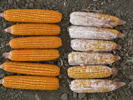 |
|
Figure 17 |
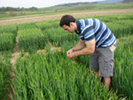 |
|
Figure 18 |
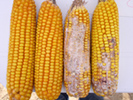 |
|
Figure 19 |
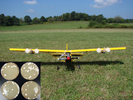 |
|
Figure 20 |
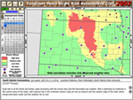 |
|
Figure 21 |
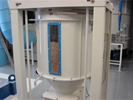 |
|
Movie 2 |
Management of mycotoxins involves practices that are employed pre-harvest, during harvest, and post-harvest (including detoxification approaches). Post-harvest management can include not only the practices directed at reducing mycotoxin levels, but also the management of mycotoxin-related risk by directing contaminated products to less sensitive uses, or controlling its use through regulation. Monitoring or surveillance of mycotoxin levels in crops and products is an important management tactic and it can be implemented pre-harvest and post-harvest.
Pre-harvest strategies primarily consist of tactics designed to reduce infection by mycotoxin-producing fungi, and fall into these three categories: (1) genetic resistance and other cultivar characteristics, (2) cultural practices (planting & harvest dates, tillage practices, crop rotation, plant population, irrigation, sanitation), and (3) crop protection chemicals (insecticides and fungicides) or biological control.
Among the crops affected by mycotoxins, maize and wheat have been subjected to the most intense efforts to develop genetic resistance in commercial cultivars. As a result, it is possible to select maize hybrids [Figure 17] and wheat and barley varieties [Figure 18] with partial resistance to mycotoxin-producing fungi. However, the genetics of resistance to these fungi has proven to be complex, and high levels of resistance are not yet available in high-yielding, commercially popular cultivars. Resistance to Aspergillus flavus in nut crops also has been studied, especially in peanuts, but this has not yet led to commercial cultivars with resistance to aflatoxin contamination. Infection of maize kernels by Fusarium verticillioides and Aspergillus flavus is promoted by insect injury, and therefore, insect resistance provided by transgenic Bt proteins has proven valuable in reducing fumonisins and (less consistently) aflatoxins in maize kernels [Figure 19]. Other genetically controlled host plant characteristics also can impact vulnerability to mycotoxin contamination. For example, small grain crops that are self-pollinated have less ergot infection than cross-pollinated crops (like rye) whose unpollinated floral parts remain susceptible for a longer duration. Genetic resistance to these mycotoxin-producing fungi remains a high priority and may eventually be greatly enhanced through the use of genetic engineering.
Cultural practices can be adjusted to reduce survival or spread of mycotoxin-producing fungi in the field, or to avoid mycotoxin contamination of the crop through timing of planting and harvest. Because most mycotoxin-producing fungi survive in crop residue, some reductions in contamination can be achieved through crop rotation, tillage, or other sanitation practices. The success of this strategy is limited, however, due to the ability of these fungi to spread by airborne spores over fairly long distances [Figure 20]. Cultural practices such as plant spacing, fertilization, weed control, and irrigation can be altered to promote environmental conditions that are less favorable to infection, by discouraging fungal development or reducing plant susceptibility.
For some crops, infection can be reduced through the use of fungicides, insecticides, or biological control agents. Insecticides can be partially effective only for those infections that are associated with insect injury. Fungicides are widely used in wheat to prevent infection by Fusarium graminearum and other fungi that cause Fusarium head blight. Gauging the need for fungicides and optimizing the timing of applications has been greatly improved through the development of risk-assessment models, which are available on-line for many wheat-growing areas [Figure 21]. Properly timed fungicide applications can reduce infection and mycotoxin contamination, but disease control does not always result in reduced mycotoxin contamination. Biological control methods have been developed for Fusarium head blight of wheat and for A. flavus infection of cottonseed and other crops. For Fusarium head blight, microorganisms that are antagonistic to the Fusarium pathogens are applied to the wheat heads. The A. flavus biological control strategy involves the application of an atoxigenic strain of A. flavus to the soil surface, which then colonizes the crop and out-competes the existing toxigenic strains.
Postharvest strategies for managing mycotoxins fall into the following general categories: (1) drying and storage management, (2) sorting or other physical separation, and (3) detoxification.
For most of the agricultural products affected by mycotoxins, post-harvest drying and maintaining proper storage conditions are key elements of a mycotoxin management plan. Fungal growth and mycotoxin production can be prevented when the moisture content of the product is held below a critical level; optimal moisture contents have been determined for the storage of cereal grains, beans, and nut crops. Control of storage temperature also is very important. These tactics are easily implemented in developed countries, but can be very challenging in developing countries where adequate drying and storage facilities are not available.
Grain or nuts that are infected by mycotoxin-producing fungi often have visual symptoms or other physical characteristics that allow them to be separated from the healthy product. This can be a very effective way to reduce the mycotoxin level in a grain lot without removing a large proportion of the product. Methods include air-screen cleaners, optical sorters, and density separation [Movie 2]. In addition, the pericarp or hull of the grain often contains the most concentrated mycotoxins, and de-hulling methods also have been shown to greatly reduce mycotoxin contamination. Finally, in some cases, whole lots of contaminated grain are diverted from use as human food or feed for sensitive livestock species, and instead fed to less-sensitive livestock, such as mature beef cattle.
Detoxification of contaminated products can be achieved by thermal, biological, or chemical means. Thermal inactivation of mycotoxins usually is implemented as a stage in food or industrial processing. Most mycotoxins are relatively heat stable, and it can be difficult to significantly reduce mycotoxin levels while maintaining product quality. Microorganisms have been identified that are capable of metabolizing certain mycotoxins. In particular, bovine rumen microorganisms have been shown to detoxify DON under some conditions, and a feed additive based on at least one of these organisms has been developed. Various chemical methods have been developed with some success in breaking down mycotoxins in postharvest products. The most well-known approach is the use of ammonia gas or ammonium sulfate to reduce aflatoxin levels in maize. This is a widely accepted practice internationally, but is not used extensively in the U.S. Other approaches include solvent extraction of contaminants from feed and adding mycotoxin binding agents to feed. In general, detoxification is one of the least preferred approaches to managing mycotoxins, due to the expense and the limitations sometimes placed on the use of decontaminated grain.
A common approach used in food safety programs is HACCP, or Hazard Analysis Critical Control Point. This approach has been recommended and implemented in relation to preventing mycotoxin contamination of food products. HACCP for mycotoxin prevention is a proactive food management system based on the control of processes and materials all along the supply chain. The approach is based on seven principles:
- Identification of hazards; assessment of risk; description of control measures
- Identification of the critical control points (CCP)
- Establishment of critical limits
- Establishment of procedures for monitoring of CCPs
- Establishment of corrective actions
- Establishment of verification procedures
- Documentation and record keeping
HACCP programs have been established for mycotoxin control in various crops including maize, coffee, nut crops, and apples in a number of different countries. The approach is well-suited for mycotoxins because it can reduce the need for costly end-point testing for quality control.
Next: Detection of mycotoxin contamination
